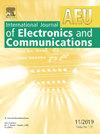Compact polarization-reconfigurable AFSIW array with integrated biasing network
IF 3.2
3区 计算机科学
Q2 ENGINEERING, ELECTRICAL & ELECTRONIC
Aeu-International Journal of Electronics and Communications
Pub Date : 2025-09-27
DOI:10.1016/j.aeue.2025.156042
引用次数: 0
Abstract
A polarization-reconfigurable antenna array with an integrated biasing network is demonstrated using air-filled substrate-integrated waveguide (AFSIW) technology for the [7.75–8.25] GHz sub-band of Frequency Range 3 (FR3). The antenna element features a compact 0.6 footprint, utilizing a U-shaped slot within a quarter-mode AFSIW topology. Two PIN diodes enable +45°/-45°polarization switching by electrically shorting the slot at well-defined positions. Their DC bias is provided through inductive vias, which are isolated by capacitive gaps, allowing seamless integration without additional biasing components. The stand-alone antenna prototype was fabricated using low-cost printed circuit board (PCB) technology. Moreover, a 2 × 2 array was fabricated to validate the platform’s scalability. Measurements reveal a -10 dB impedance bandwidth of 590 MHz (7.46%) for both the single element and the array. The stand-alone antenna achieves a peak gain of 5.18 dBi, 91% efficiency, and 16.5 dB boresight cross-polarization discrimination across the entire frequency band. The array achieves a peak realized gain of 9.5 dBi, with embedded element radiation patterns closely matching the single-element patterns owing to mutual coupling remaining below -15 dB. 2D steering was demonstrated in simulation for a 4 × 4 array up to 40. Measurement results align closely with simulations, confirming effective polarization reconfigurability, making the design well-suited for next-generation FR3 communication systems.
集成偏置网络的紧凑型极化可重构AFSIW阵列
在频率范围3 (FR3)的[7.75-8.25]GHz子带上,采用充气基片集成波导(AFSIW)技术演示了具有集成偏置网络的极化可重构天线阵列。天线元件的特点是紧凑的0.6λ0×0.6λ0占地面积,利用四分之一模式AFSIW拓扑中的u形插槽。两个PIN二极管通过在定义位置的槽电短路实现+45°/-45°极化开关。它们的直流偏置是通过电感过孔提供的,电感过孔由电容间隙隔离,无需额外的偏置组件即可实现无缝集成。独立的天线原型是使用低成本的印刷电路板(PCB)技术制造的。此外,还制作了一个2 × 2阵列来验证平台的可扩展性。测量结果显示,单元件和阵列的-10 dB阻抗带宽为590 MHz(7.46%)。该独立天线在整个频带内的峰值增益为5.18 dBi,效率为91%,轴视交叉极化判别为16.5 dB。该阵列的峰值实现增益为9.5 dBi,由于相互耦合,嵌入元件的辐射方向图与单元件的辐射方向图紧密匹配,保持在-15 dB以下。仿真验证了4 × 4阵列40°的二维转向。测量结果与仿真结果一致,证实了有效的极化可重构性,使设计非常适合下一代FR3通信系统。
本文章由计算机程序翻译,如有差异,请以英文原文为准。
求助全文
约1分钟内获得全文
求助全文
来源期刊
CiteScore
6.90
自引率
18.80%
发文量
292
审稿时长
4.9 months
期刊介绍:
AEÜ is an international scientific journal which publishes both original works and invited tutorials. The journal''s scope covers all aspects of theory and design of circuits, systems and devices for electronics, signal processing, and communication, including:
signal and system theory, digital signal processing
network theory and circuit design
information theory, communication theory and techniques, modulation, source and channel coding
switching theory and techniques, communication protocols
optical communications
microwave theory and techniques, radar, sonar
antennas, wave propagation
AEÜ publishes full papers and letters with very short turn around time but a high standard review process. Review cycles are typically finished within twelve weeks by application of modern electronic communication facilities.

 求助内容:
求助内容: 应助结果提醒方式:
应助结果提醒方式:


